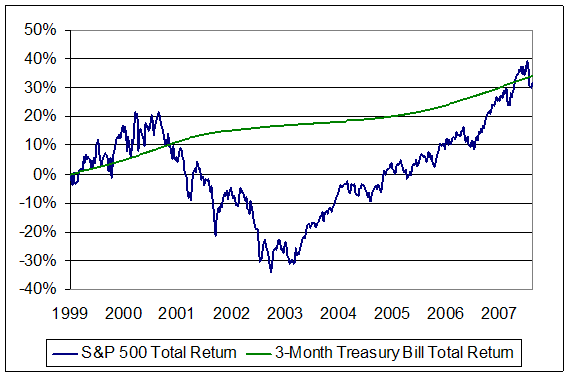I spotted this chart on another forum...is anyone else concerned when stock returns appear to be doing well year-to-year, yet over the medium term they've been mostly flat versus a "risk-free" bond. Then when you take out inflation (+3%/year), taxes (~2%/year), and the decline in the value of the dollar (depends on which foreign currency you benchmark but it's substantial, as anyone who's been to Europe lately knows) and you've actually lost purchasing power over the last 8 years.
Obviously, this chart was put together by a perma-bear, he selected a particular time scale to make his point...but even so, I think it's easy to be fooled by reporting a 10% "average annual return" on your investments but in reality your true return is much less. The author also ignores the benefits from a more diversified portfolio over this time period - but when I look at returns YTD 2007, there seems to be a lot of correlation between large cap, small cap, and international stocks, particularly on the market's bad days, so I'm not sure diversification is enough to save us all.
Of course, I don't know what other investment options there are that
would have a better chance of generating real returns...

Obviously, this chart was put together by a perma-bear, he selected a particular time scale to make his point...but even so, I think it's easy to be fooled by reporting a 10% "average annual return" on your investments but in reality your true return is much less. The author also ignores the benefits from a more diversified portfolio over this time period - but when I look at returns YTD 2007, there seems to be a lot of correlation between large cap, small cap, and international stocks, particularly on the market's bad days, so I'm not sure diversification is enough to save us all.
Of course, I don't know what other investment options there are that
would have a better chance of generating real returns...



